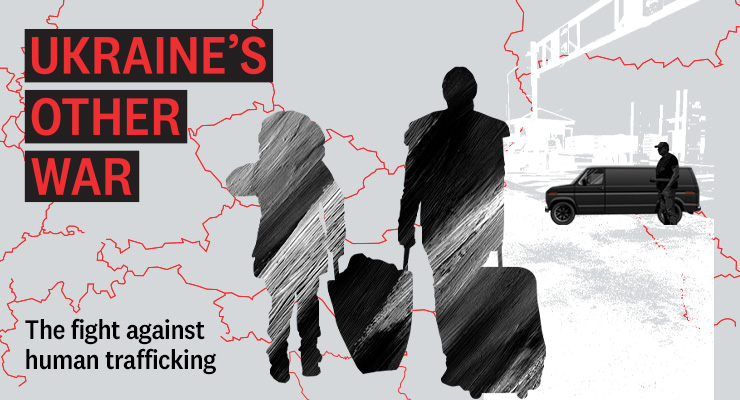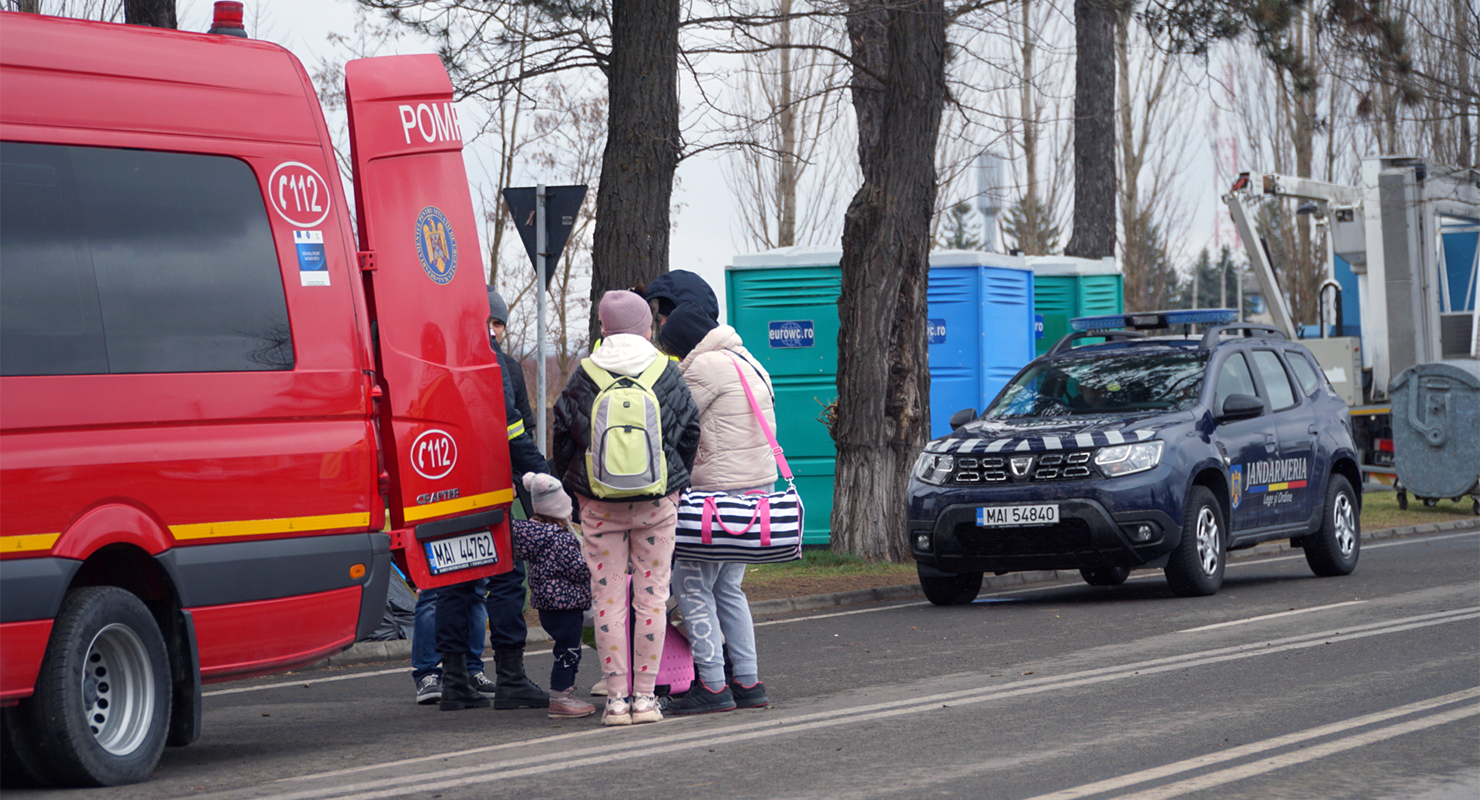
This is part one in a series. For the rest of the series, go here.
More than 10 million Ukrainians have left their homes since Russia’s invasion began two months ago. At least half of those people have fled the country — mostly women, children and the elderly, with men of fighting age or those working in essential industries forced to stay behind.
Children have had to cross borders alone while grandparents chaperone their grandchildren and their friends’ grandchildren. Mothers, their arms full of their life’s possessions, navigate systems in foreign languages, dealing with trauma, fatigue and worry. After weeks of sleeping on cold basement floors, hearing shelling and air-raid sirens go off around them, many refugees are on the brink of delirium.
They’re prime targets for human traffickers who, either working for a known organisation or acting alone, seek to send them into sexual slavery or labour exploitation. Children make up a third of all known trafficking victims — a proportion that has tripled in the past 15 years. Women make up the bulk of victims, with most subject to sexual exploitation.

The risk of human trafficking is well known, with police and NGOs primed to look out for risks. But the war erupted suddenly. Within one week of Russia’s invasion, more than a million people had already fled. Humanitarian workers describe 20 kilometres of cars waiting at the border crossing — at least 4000 vehicles attempting to cross at a single border point.
The sheer scale of the crisis meant many important safeguards to protect refugees weren’t immediately implemented. Two months into the crisis, many protections are still lacking.
Unidentified “volunteers” can still wander in and out of a multitude of refugee hubs and transit centres across Europe, offering rides and services to Ukrainians — in some cases, for a fee. Background checks still haven’t been implemented for volunteers and host families across Poland. In Siret, Romania, unaccompanied minors weren’t identified and assisted by social services for the first week of the crisis, left to travel onward alone. And in Palanca, Moldova, shady characters in expensive cars approach refugees offering expensive lifts to wherever their hearts desire.

No long-term accommodation has been set up for Ukrainians, with many staying with friends, family or hosts they met online. One man in Norway has been charged with raping a 17-year-old in his home, just days after she entered the country.
Authorities are attempting to crack down on traffickers with sting operations and online investigations, while NGOs are attempting to vet volunteers and limit who can approach refugees. But many of these actions come too little too late — meaning the full scale of abuse and exploitation is still unknown.
The longer the war goes on, the more vulnerable Ukrainian refugees become as they struggle to start their new lives or wait in limbo to return home.
In this multi-part investigative series, Crikey explores the risk factors for trafficking across central Europe, looking at what’s being done about it — and where local governments lag behind.
To read the next part in this series, click here.








Interesting story Amber, so these exploiters live and work in the so called west. What’s gone wrong with western democracy, has it failed. Are you going to do a story on Turkey’s invasion of Northern Iraq, western democratic media is rather silent about it at present, perhaps Crikey can correct it.
Do you actually have a point, or do you think your comment makes you seem edgy? Because tbh, it’s a totally pointless and senseless comment.
Three people think I have a point you spineless POS.
Still wonder how his comments pass moderation, e.g. the following one using a well known abusive and uncouth acronym yet anodyne comments go to moderation?
Crikey needs clearer guidelines on comments as too much wriggle room for those who have nothing to offer but personal barbs…….. then again exemplifies Oz and our media….
That acronym is also commercially “Point of Sale” – shouldn’t confuse a person, but may confuse an automated system in spite of the word before it.
I am not downplaying the Ukrainian refugee crisis but where did you get the number that 10 million people had left the Ukraine?? Maybe that many people have been displaced internally which is a humanitarian disaster in itself.
Its in the article – about half have fled the country. The rest are internally displaced.
The ones who fled to Russia are being well looked after, 70% of Ukraine’s have Russian relatives so there won’t be any exploitation there in vast numbers.
Dear God, are their lives not precarious enough they now have to worry about slavery?
Sometimes I despair for this world.
It’s not Putin’s war. It’s America’s proxy war to fight Russians down to the last Ukrainian.
Biden blurted it out, not that we hadn’t already worked it out what the Tyrants of the Ptomac were up to.
Nothing wrong with being concerned with refugees and trying to help them, but there are 14,000 people over in the east who are dead, 24,000 injured (missing arms and legs included) and many thousands homeless. Ukrop have used Grad missiles against the civilian population in east Ukraine amongst other weapons like drones and good old artillery. They have done this for eight years.
The Russians will win this war and because Zelensky is a puppet of the ultra-nationalists who are fully supported with training weapons, strategic and tactical advice by the US, the UK and Canada, he won’t throw in the towel even though his army is being ground into the earth with massive casualties. His sponsors want the war to last as long as they can to weaken Russia.
If he does surrender he will be seen by the ultra-nationalists as a collaborator and will be executed by them.
For those of you who don’t use Grad rockets in your neighborhood here is a little bit of info on the ones Ukrop have been using against the Donbas regions civilians:
Grad rockets, often fired in salvos (multiple launchers), make a very distinctive low rumble. Within seconds, a Grad rocket launcher can fire off its 40 rockets, raining them down like hail (Grad is hail in Russian).
Grads are notoriously indiscriminate. Once fired, these unguided rockets can land anywhere within a rectangle of approximately 54,000 square meters, roughly seventy urban house blocks. The most common type contains approximately 6.4 kilograms of high explosive to produce some 3,150 fragments. These fragments can then kill or maim for a radius of twenty-eight meters. (Various sources)
Just imagine if a salvo of these ended up in your neighborhood. That would certainly put a crimp on your day.
What’s going to happen next? Well Poland has been given the green light by the US to invade West Ukraine, that’s why we have the latest Russian Rhetoric about lightening responses to interference and it’s why Blinken and Austin visited Poland last week.
Poland has been itching to get involved as they hate both the Ukrainian neo-nazis and Russians; they had a difficult experience with a similar organization in WWII and Russia invaded them after that particular war. Two birds with one Polish stone you could say. If Poland do invade then they will do so without the NATO fig leaf. Russia might let them, as this would take West Ukraine off the “playing field” making it one less thing for Russia to worry about.
On the other hand Russia might just blow them up. We will have to wait and see.
I reckon it will be the latter, as that is what Putin has aid as Russia knows exactly what the Poles are up to. And he never bluffs.
Do you have any credible sources to support this comment that don’t include ZeroHedge, Breitbart, FoxNews, Grayzone, RT, Sputnik, Hungarian, Turkish or Serbian media; worse than opinions, it’s simply conspiracy theory.
Interesting and many of the related issues are not new e.g. support for refugees in Poland and Hungary being left to NGOs, local councils and charities due to conservative national government policies, in Hungary’s case informed by Australia and US; still the case.
One would add that of late many Ukrainians have returned to western Ukraine while significant others moved onto western Europe etc. where they have community, many remain in Central European nations due to ethnic links, passports and proximity.
In the short medium term Russia is dealing with demographic and its own refugee issues e.g. estimated up to 150k IT types have emigrated in ’22 to the ‘west’, many other Russians have no choice but to stay due to family, mortgages, no languages etc..
Now the existential fear of proxy mobilisation and call up of males from western Moscow/St. Petersburg i.e. nominal middle class elites becoming involved in Ukraine in addition to the regional ‘contractors’ who have taken the most losses, but the risk of inducing Putin’s real fear, street protests (while his inner and upper circles are being strangled by sanctions).